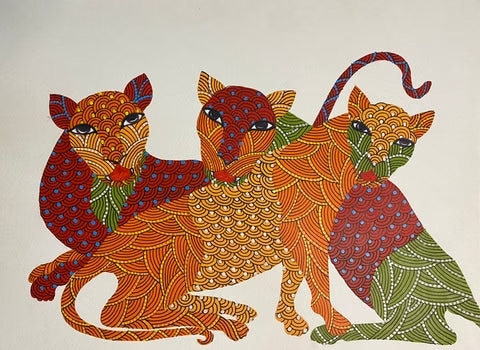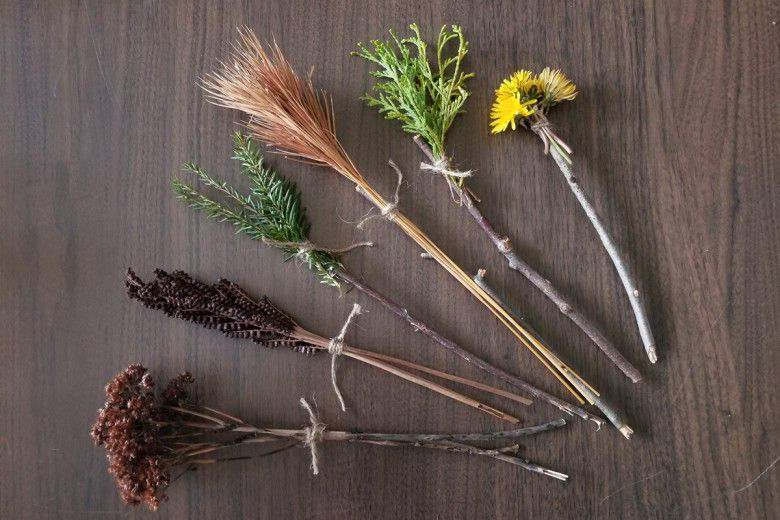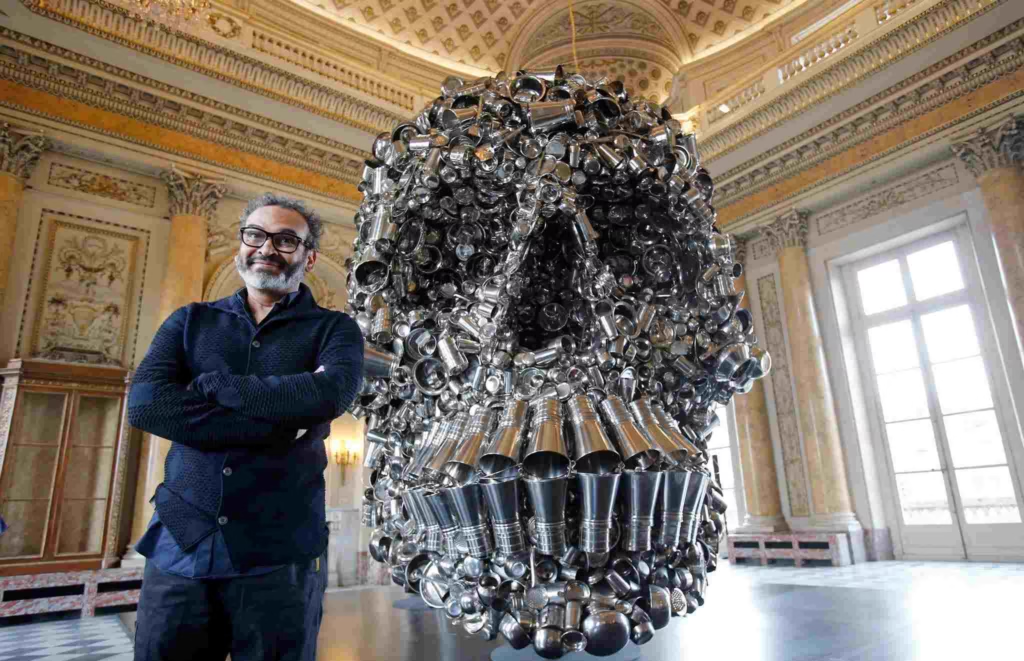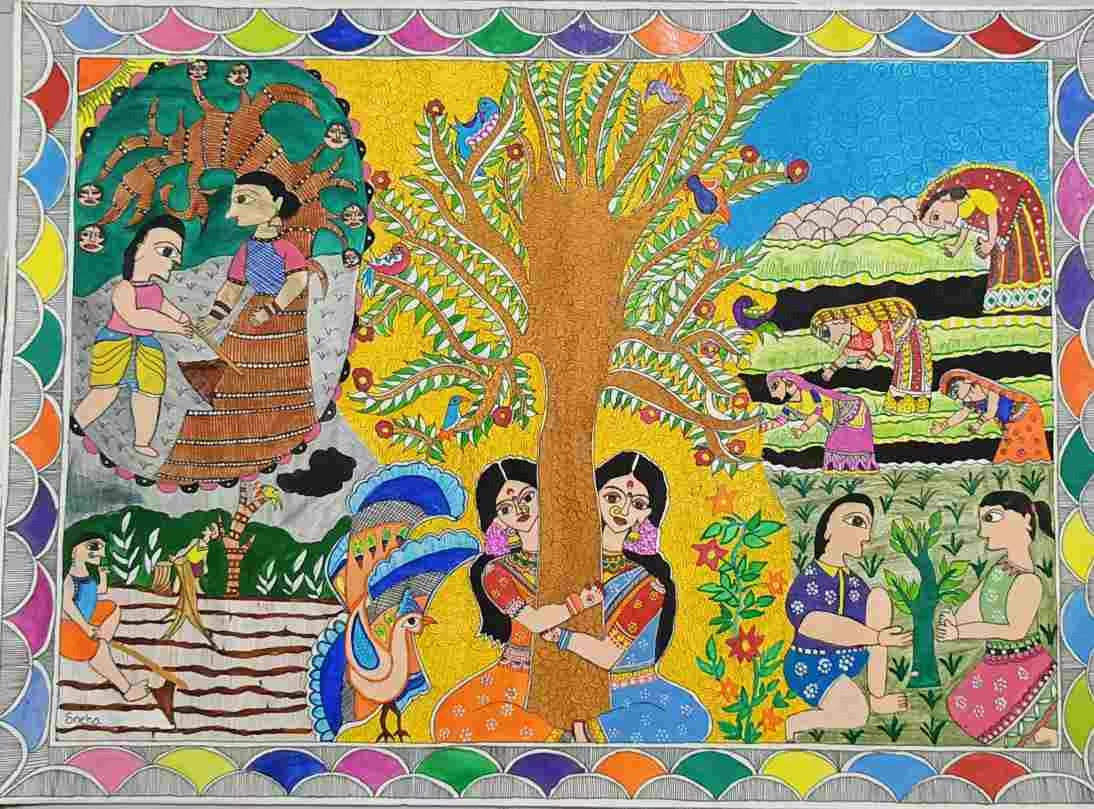What is Ecological Painting?
Ecological painting is an art form rooted in sustainability. It uses natural, non-toxic materials. These include organic pigments, plant-based dyes, and biodegradable canvases. Artists avoid synthetic chemicals and plastics. The focus is on minimizing environmental impact.
This practice celebrates harmony with nature. It often reflects themes of biodiversity and conservation. For example, earth pigments like ochre, sienna, and umber are common. These are extracted from the soil. Vegetable dyes from turmeric or indigo replace synthetic hues. Eco-friendly binders like casein or egg tempera are used instead of petroleum-based products.

Ecological painting also reduces waste. Artists repurpose materials like recycled paper or wood. Some create on handmade canvases. The goal is zero waste and low carbon footprint. This art form is gaining global traction. In 2022, the eco-art market grew by 15%. More than 40% of emerging artists used sustainable practices. Collectors are drawn to its authenticity. Galleries highlight its relevance in climate change discourse.
Ecological painting challenges consumerism. It questions our relationship with nature. Every brushstroke is a protest. Every pigment is a story. This isn’t just art; it’s advocacy. It’s a quiet, vivid rebellion.
The Rise of Ecological Painting in Modern Art
The walls breathe differently now. Ecological painting isn’t just pigment on a canvas; it’s a slow rebellion. A rebellion against the factories belching smoke, against rivers bleeding chemicals, against the art that once turned its back on the earth.
These painters, their hands stained with ochre and turmeric, seem to whisper to the world. Brushes carved from bamboo dance over surfaces that carry history—canvas made of hemp, paper pulped from recycled stories. The Lost Wax Casting of the Chola artisans, perhaps, found its distant kin in the quiet revolution of ecological painting.

In 2022, the Venice Biennale murmured a shift. Solar-powered galleries housed works that did not wound the earth. The carbon footprint of the art industry, a silent giant, trembled at the sight of murals made from mud, seashells, and crushed berries.
Each painting seems to mourn and celebrate all at once. The ocean in their strokes remembers its plastic burden; the forests in their greens carry the ache of deforestation. This isn’t just art. It’s a lullaby for a broken world. A manifesto painted with ash and hope. Ecological painting is the reminder that beauty, when tethered to destruction, ceases to be beautiful at all. Here, beauty finds redemption. Here, art begins to heal.
What are the Materials Used in Ecological Painting?
Ecological painting is a dialogue between the artist and nature, a commitment to using materials that preserve rather than harm. The materials used are as much a part of the message as the art itself. No longer can one ignore the impact of synthetic paints, laden with toxic chemicals, on the environment. The shift toward ecological painting begins with the very materials an artist selects.

Natural pigments are the cornerstone. Derived from earth, plants, minerals, and insects, these pigments have been used for millennia. Ochre, derived from clay, provides rich yellows and reds. Indigo, once harvested through labor-intensive processes, gives deep blues. The vibrancy of these colors is unmatched, and they are free of the harmful chemicals that synthetic pigments carry. Today, artists are turning to these time-honored pigments, as they not only offer authenticity but also a deeper connection to the land.
The canvas, too, has evolved. Artists are opting for hemp, bamboo, or recycled cotton over traditional canvas. Hemp, with its minimal water needs, is a sustainable choice. It grows rapidly and requires fewer pesticides, making it ideal for eco-conscious artists. Bamboo, known for its regenerative properties, is another popular surface for ecological painting. The switch to these materials reduces dependence on cotton farming, which is often water-intensive and pesticide-heavy.
Natural brushes, crafted from bamboo and plant fibers, replace synthetic brushes. These brushes are biodegradable and free from plastic, ensuring that the artist’s environmental footprint is as light as possible. In place of synthetic brushes, hog bristle brushes, derived from animal hair, have been used in traditional art but are now increasingly replaced by plant-based alternatives, which are cruelty-free and eco-friendly.

Brandywine Conservancy and Museum of Art
Binders used in ecological painting are equally important. Traditional methods favor gum arabic, a natural resin harvested from acacia trees. It serves as an adhesive that binds pigments together. Beeswax, another binder, is used to give the paint texture and depth. These natural resins are both sustainable and non-toxic, in stark contrast to the acrylic or oil-based binders that flood the market today.
Every choice in ecological painting—from pigment to surface to brush—reflects a philosophy: a return to simplicity, an acknowledgment of the earth’s resources, and a commitment to preserving them for future generations. Artists who embrace this method are not just creating art; they are crafting a future where beauty and sustainability coexist.
Techniques that Define Ecological Painting
One of the key techniques is wet-on-wet painting. This approach involves using water-based paints that blend into each other, minimizing the need for multiple layers of toxic chemicals. It reduces the consumption of materials and allows for a softer, organic feel to the artwork. The use of natural pigments, such as ochre, indigo, and turmeric, is integral to this method. These pigments are not only biodegradable but also carry the deep, earthy tones that resonate with nature.
Another technique is earth-textured painting. Artists incorporate soil, clay, and sand into their works, creating rich, tactile surfaces. These materials come directly from the land, offering a sense of grounding. The result is a piece that feels ancient, timeless, and connected to the environment. Artists use locally sourced materials, further reducing their carbon footprint and supporting regional economies.
Minimalist layering is another prominent feature of ecological painting. Artists aim to use fewer materials. By embracing simplicity, they reduce the environmental impact. Fewer synthetic layers are applied to the canvas, creating a more sustainable approach. This technique encourages a deeper connection with the medium itself, rather than masking the surface with excess paint.
Natural brushes also define ecological painting. Instead of using synthetic fibers, artists opt for brushes made from bamboo handles and plant-based bristles. These tools are biodegradable and sustainably sourced, unlike the plastic-bristled brushes that often fill art supply stores. They not only contribute to the eco-friendly approach but also offer a unique texture and precision that synthetic brushes cannot replicate.
Lastly, recycled surfaces are becoming increasingly popular. Artists are moving away from traditional canvases in favor of using recycled paper, fabric, or reclaimed wood. This technique reduces waste and gives new life to materials that would otherwise end up in landfills. These surfaces bring their own character, imbuing the art with a history of transformation.
The Role of Ecological Painting in Environmental Awareness
Ecological painting provides clear, measurable benefits for both artists and the environment. Artists using natural materials, such as earth pigments and non-toxic paints, avoid exposure to harmful chemicals commonly found in synthetic paints. These chemicals, including lead and cadmium, pose significant health risks, causing respiratory issues, skin irritation, and long-term neurological damage. In contrast, ecological painting materials are safe, reducing these risks for artists.
For the environment, ecological painting minimizes pollution. Traditional paints, produced with petrochemical derivatives, contribute significantly to environmental degradation. According to a study, the global paint industry produced an estimated 2.9 million tons of volatile organic compounds (VOCs) in 2019, which contribute to air pollution and harm ecosystems. By using biodegradable materials, such as natural pigments derived from minerals or plants, artists reduce this environmental impact. These pigments break down naturally without contaminating the land or water.
Famous Artists Practicing Ecological Painting
In the world of ecological painting, there are few who wield their brushes with the same urgency as the ones who have come to understand that art cannot be separated from the Earth. Subodh Gupta, India’s own artist, doesn’t merely paint; he takes what is discarded—metal, plastic, refuse—and shapes them into works that question the narratives of consumption.
Subodh Gupta’s art speaks of India’s unrelenting race toward industrialization, a race that leaves behind debris. Gupta’s sculptures, his installation art, are full of rust and remnants, the very material of our environment’s degradation. But there’s more to him than art; there’s a message. He reminds us, in his use of scrap, that the Earth is a repository of all we’ve abandoned.

Ravi Agarwal, another artist who has learned to listen to the land, uses ecological painting to speak of what is dying, what is suffocating under our weight. Through his “Water” series, Agarwal’s art captures the decaying rivers and lakes of India, those lifebloods of the land that now carry the poison of neglect. His canvas might be oil-based, but his paints are made from natural, sustainable pigments that connect him to the land he seeks to save.
Across the globe, the narrative deepens. John Sabraw, with his quiet revolution, takes polluted river water in Ohio and turns it into a pigment. He removes the toxins from the river, and what is left is not just cleaned water—it is the vibrant hue of art. From a place that once symbolized loss, Sabraw creates something restorative. His paintings, made with pigments born from pollution, speak of reclamation.
El Anatsui, from Ghana, stands apart as an artist who takes waste—discarded metal bottle caps—and transforms them into shimmering sculptures that reflect the fragility of our systems. Though not strictly ecological painting, his work resonates with the same spirit. He asks the question: Can we ever return to a state of balance, or is all that is left the accumulation of waste?
How to Get Started with Ecological Painting?
To embark on ecological painting, one must first dismantle the illusion that art exists in a vacuum, separate from the soil, the air, and the pulse of the earth itself. The process demands more than simply choosing “eco-friendly” materials. It calls for an intimate understanding of how pigments, brushes, and even the canvases we use are woven into the planet’s delicate fabric.
Start with natural pigments, those deep, ancient hues extracted from the earth, from plants and minerals, that have survived millennia. Ochre, the yellow-brown pigment once painted on cave walls in India and Australia, is a direct connection to the land. It costs little, but carries the weight of history in its strokes. Indigo, once the prized dye of India’s artisan class, still holds a certain mystery. It’s not just a color, it’s a story of colonial exploitation, of cultivation, and of resistance. Turmeric, golden and fragrant, also paints the walls of temples and homes alike. These pigments are free from synthetic chemicals—no chromium, no cadmium, just pure earth.
Then there are the surfaces on which to paint. The canvas doesn’t have to be linen or cotton from a commercial supplier. Why not look to the lush fibers of hemp, bamboo, or even recycled paper? These materials, often discarded by industries, become a second chance for the earth’s resources. The very fibers they’re made from breathe in harmony with the painting, much like the artist.
Brushes too, demand a shift in consciousness. Replace synthetic brushes with those made from bamboo handles and plant-based bristles. Brushes made of hog hair or squirrel fur are better left in the past; they have no place in the ethical studio. Sustainable brushes are biodegradable and don’t leave a trail of plastic in the wake of your creation.
And then, the binders. The medium that holds your pigments together. Gum arabic from the acacia tree, beeswax, and natural oils are non-toxic alternatives that offer just as much depth and texture. They don’t pollute the air or the water. They’re gentle on your skin, on your lungs. Even egg tempera, with its ancient roots in the paintings of the Renaissance, calls to us—its yolk, golden and pure, binds the pigment without chemical intervention.
Finally, one must master techniques that embrace minimalism. Paint in layers, yes, but be frugal. The earth does not waste, and neither should you. The wet-on-wet technique uses water as a binder, letting the pigments flow without excessive waste. Use the water as the medium, not a crutch to carry synthetic waste.
This isn’t merely a practice of creating something beautiful. It is a reminder of the world we have almost lost, the one that resided in the rituals of ancient artists who knew nothing but to take what the earth gave and return it with love. In ecological painting, we do not just mix colors; we mix memories, histories, and futures. It is not a retreat into a past that we can never revisit but a future that we are slowly learning to build. And in doing so, we honor the earth, the material we’ve forgotten to love.
Challenges in Embracing Ecological Painting
The materials—natural pigments, handmade brushes, biodegradable canvases—are expensive. A small jar of ochre pigment can cost up to $50, while synthetic alternatives sit at a fraction of the price. This price tag is not just a number; it is a gatekeeping device, excluding many artists from embracing sustainability.
The difficulty extends beyond cost. Sourcing these materials is a labyrinthine task, with local suppliers often holding the keys to pigments that have been harvested in remote corners of the world. Indian indigo, for example, comes from a rare plant, its cultivation restricted by geography and season. So, when artists seek to source it, they are often left with nothing but a list of names on the internet—a map to nowhere.
And then, there’s the knowledge, the knowledge that is buried deep in history, passed down through generations. Natural pigments are capricious; they fade, they react with moisture, they cannot simply be used in the way commercial paints are. The learning curve is steep, the risk high. It is a tradition lost, one that needs to be resurrected with care.
Even if the materials are found, even if the knowledge is revived, the broader art world does not embrace it. The galleries remain wedded to the industrial, the mass-produced. Ecological art remains relegated to the fringes, like an inconvenient truth nobody wants to hear. These challenges, however, are not roadblocks—they are the very foundation of ecological painting’s power. For in embracing the struggle, the artist does not just create; they resist.
Why Ecological Painting is the Future of Art?
This movement is not just a trend but a necessary evolution. In 2020, the global market for eco-friendly paints was valued at USD 5.2 billion and is expected to grow by 4.5% annually. As more artists adopt ecological painting practices, the art world will shift towards sustainability, proving that creativity and environmental responsibility can coexist. Ecological painting is not just art—it’s a movement for change.
Ecological painting is not merely a passing trend; it is the art world’s necessary reckoning. Artists, in their quiet rebellion, are turning away from synthetic pigments—those chemicals laced with toxins that leach into the earth, air, and water. We, as consumers, are complicit in this destructive cycle. Conventional paints, largely petroleum-based, not only contribute to pollution but also release volatile organic compounds (VOCs) into the air, which remain for years, altering the very atmosphere we breathe.
This is why ecological painting, with its emphasis on natural pigments, is revolutionary. Iron oxide, cobalt, and the humble clay-based ochre are but a few examples of materials that have been around for centuries. They offer richness, depth, and vitality, without the environmental toll of their synthetic counterparts. Such pigments are often mined from the earth’s crust or extracted from plant life, with minimal environmental disturbance.
According to a 2021 report from Allied Market Research, the global eco-friendly paint market is expected to reach $15.65 billion by 2030, growing at a CAGR of 7.3%. This shift is not only visible in the world of architecture and interior design but is now echoing in the halls of art galleries and studios. Eco-conscious artists are increasingly selecting materials that speak to a larger truth—that art, in its essence, can be both a mirror to our times and a call to action for the preservation of the very planet it captures.
Ecological painting, thus, is not just an aesthetic choice. It is a moral one. It signifies a refusal to engage in artifice and pollution, choosing instead to work with what the Earth offers—untouched and whole. The future of art lies not in synthetic glitters but in the organic, in the tactile touch of the Earth’s hand against the canvas.
For further reading on and its significance, you can visit these useful resources:
Check out our Blog Page on Traditional Indian art.


Leave a Reply